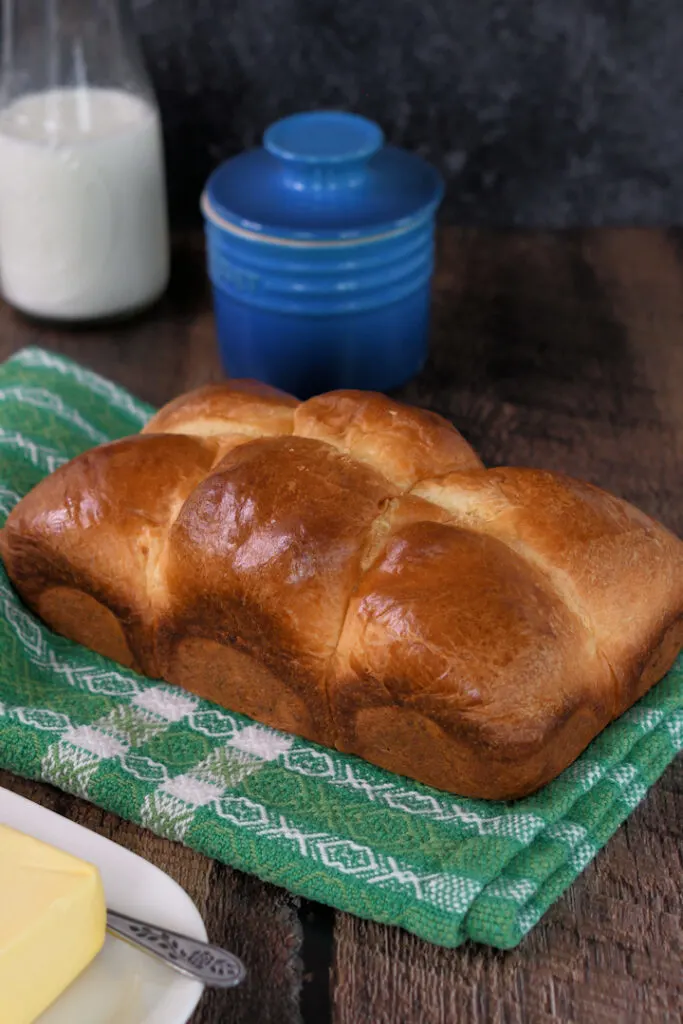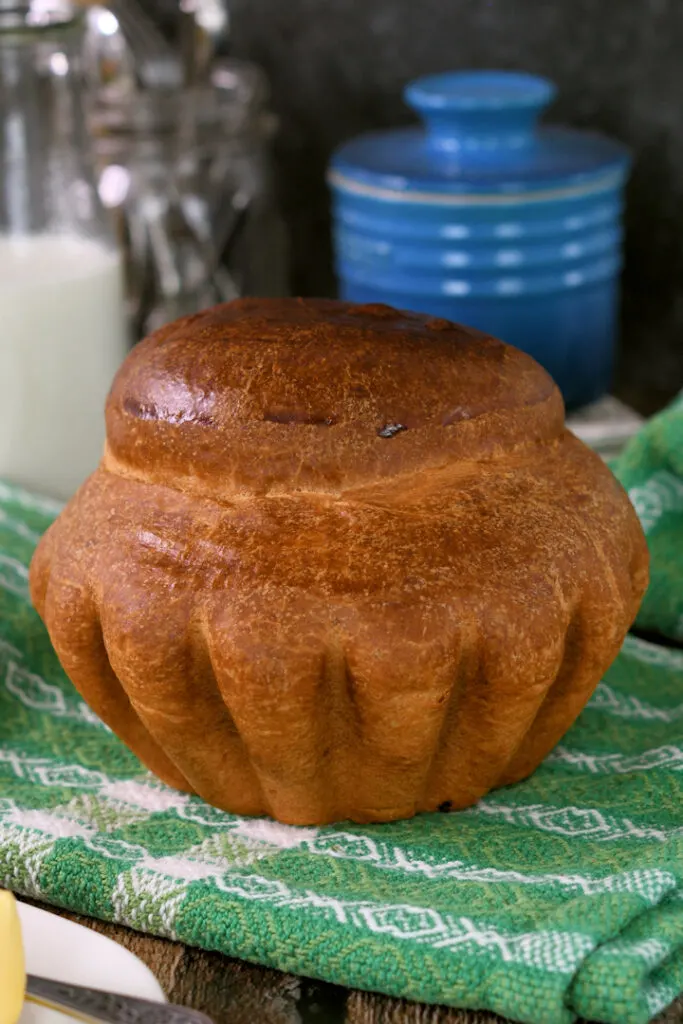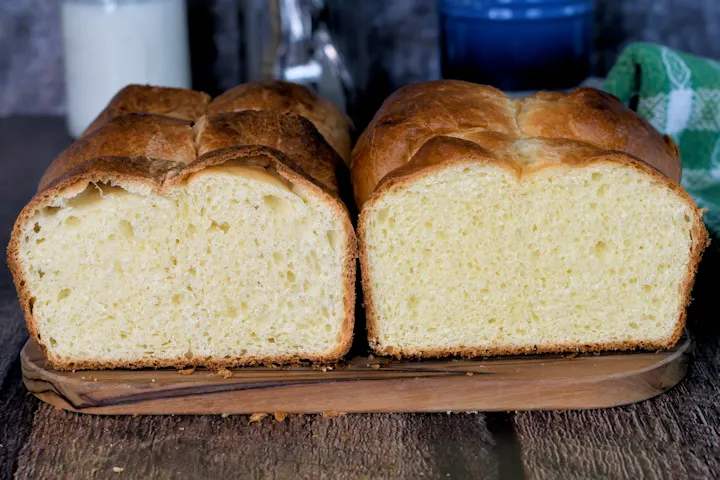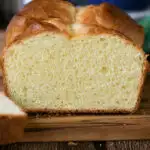Sourdough Brioche with video
Sourdough Brioche! The classic bread is enhanced with sourdough starter. The dough bakes up to a light and silky bread. It’s also the starting point for many delicious pastries.

If you don’t already have one, I can show you how to make a sourdough starter and how to feed a sourdough starter.
In the meantime, you can make Classic Brioche Bread with commercial yeast.
A timeline for making Sourdough Brioche Bread:
- If your starter needs feeding, do that the night before or early in the morning of the day you want to make the dough.
- Mix the dough in the afternoon. Allow it to ferment at room temperature for several hours.
- Form the loaves. Cover the pans with plastic wrap and place them in the refrigerator over night. Take the pans out in the morning.
- Leave the loaves at room temperature to rise for 2-3 hours. The rising time will vary based on the ambient temperature and how active the dough was over night.
- You can have fresh bread for breakfast or brunch.
FAQs about making Sourdough Brioche Bread:
Well, technically, since Brioche was made long before stand mixers were invented it is possible. But it’s not easy without a stand mixer. You have to fold and u0022slapu0022 the dough on the work surface for a good 20-30 minutes to develop gluten. Traditional kneading with your hands would warm up the dough too much.
I recommend using European butter because the lower water content means the butter is more pliable at cooler temperatures. This makes it easier to incorporate the butter into the dough. You can use American butter, just make sure it’s pliable, but not melting.
The long kneading process is imperative to a great loaf of Sourdough Brioche bread. Because of the high butter content, you need well-developed gluten to help the bread rise and hold the air pockets.
The long slow rise in the refrigerator enhances the flavor and texture of the bread. The time in the refrigerator also chills and firms up the butter in the loaf, making is less likely to leak out during baking.
Because of it’s enriched and slightly sweet crumb, Sourdough Brioche can be the basis of many other tasty treats. Roll the dough, sprinkle with cinnamon sugar and raisins, then swirl into a loaf to make cinnamon raisin bread. Shape the dough into Sourdough Cinnamon Buns or fill it with chocolate to make Babka.
2-3 days at room temperature.
Make French toast or bread pudding!!
Yes. Freeze either the whole loaf or slice and freeze for easy eating.
I know you hate to throw away that sourdough discard. Check out these recipes that use sourdough discard.
Watch the video to see how to make Sourdough Brioche:


If you love this recipe as much as I do, I’d really appreciate a star rating and a quick comment. Ratings and comments help my recipes show in search results. Thanks!
Sourdough Brioche
Ingredients
- 8 oz active sourdough starter (1 cup, 100% hydration)
- 2 oz whole milk (¼ cup, scalded and cooled to 110°F)
- 16 ¼ oz bread flour (3 ¼ cups, see note)
- 4 large eggs (room temperature)
- 3 oz granulated sugar (⅓ cup)
- 1 ½ teaspoons salt
- 8 oz unsalted European butter (1 cup, cool room temperature)
- 1 egg (for egg wash)
Instructions
- In the bowl of a stand mixer with the paddle attachment, combine 8 oz active sourdough starter, 2 oz whole milk and 1 cup flour. Mix to form a thick batter. Cover the bowl and set aside for 30-60 minutes.
- Uncover the bowl. With the mixer running on low, add 4 large eggs, 3 oz granulated sugar, 1 ½ teaspoons salt and another cup of the flour. Mix until combined. Switch to the dough hook. With the mixer running on low, add the remaining flour.
- Increase the speed to medium and knead the dough for 10-15 minutes until the dough gathers on the hook, becomes smooth and silky and slaps the sides of the bowl. You can add a little more flour if the dough is still too sticky after 7-8 minutes of kneading.
- If you're using a European butter you might not need to work the butter if it's already pliable. While the dough is kneading, turn the butter out onto the work surface and knead it with a bench scraper or pound it with a rolling pin until it's soft and pliable and has a similar texture to the dough. You want it pliable but not melted and greasy.
- Reduce the mixer speed to low. A tablespoon at a time add 8 oz unsalted European butter to the dough. The dough will begin to break apart, keep adding the rest of the butter. Stop the mixer and scrape the sides if the butter builds up on the bowl. Increase the speed to medium and knead until the dough comes back together, gathers on the hook and again slaps the sides of the bowl.
- Turn the dough out onto a floured surface. The dough will be quite soft and slightly sticky.
- Transfer the dough to a lightly oiled bowl, turning once to coat the dough. Cover the bowl and set it aside at room temperature for 3 hours. Every hour or so check on the progress of the dough by folding it over itself in the bowl. This will help redistribute the yeast too. After about 3 hours the dough should be lively, elastic and airy. If the dough is still sluggish give it another hour or two at room temperature. At this point you can shape the loaves, or the dough can be held in the refrigerator for up to 2 days.
- To make loaves: Butter two 9"x5" loaf pans. Divide the dough in half. Divide one half of the dough into 6 equal pieces. Roll each piece of dough under your cupped hand to form a smooth ball. Line the 6 dough balls into one of the pans into 3 rows of 2. Make the other loaf in the same way using the other half of the dough. Cover the pans and set them over night in the refrigerator.
- To make "tete" brioche: Butter two 8" brioche molds. Divide the dough in half. Divide a piece of dough into 2/3 and 1/3 portions. Form the 2/3 portion into a large ball and set it into one of the buttered pans. Roll the 1/3 portion to a teardrop shape. Poke a hole in the top of the brioche and set the teardrop, pointed side down, into the loaf. Repeat with the other piece of dough to make the other brioche. Cover the pans and set them over night in the refrigerator.
- In the morning, take the pans out of the refrigerator (if you held the dough take it out and form the loaves). Leave the loaves to rise for 2-3 hours. The exact rising time will vary based on the ambient temperature and how active the dough was prior to refrigerating. The loaves should almost fill the pans and be about double the original size.
- Preheat the oven to 375 °F. Brush the loaves with eggwash an bake until golden brown and the interior is 200 °F, about 30 minutes.
- Turn the loaves out of the pans onto a cooling rack and cool completely before slicing.
Would you like to save this recipe?
As an Amazon Associate and member of other affiliate programs, I earn from qualifying purchases.










Your brioche recipe is AMAZING. Same with cinnamon rolls, donuts…everything has been delicious! I would love to see you create a sourdough babka some day!!
Thanks Ariel, Babka is on my “to do” list.
Ooooo that makes me SO EXCITED!! I know it’ll be amazing. Really appreciate you sharing all the recipes you create! @Eileen Gray,
Love your recipes! Have done already a few and this one wasn’t different, came out perfect. Super fluffy!
Excellent recipe! My starter was a bit sluggish so I had to be patient. Texture turned out perfect. My first batch was delicious.
Thank you for this. Instructions were great! I made french toast this morning and it was delicious!